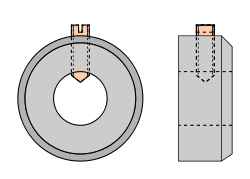- Shaft collar
-
 Shaft collar to DIN 705
Shaft collar to DIN 705
The shaft collar is a simple, yet important, machine component found in many power transmission applications - most notably motors and gearboxes. The collars are used as mechanical stops, locating components, and bearing faces. The simple design lends itself to easy installation. Many people will be familiar with shaft collars through using Meccano.
Set screw style
The first mass-produced shaft collars were set screw collars and were used primarily on line shafting in early manufacturing mills. These early shaft collars were solid ring types, employing square-head set screws that protruded from the collar. Protruding screws proved to be a problem because they could catch on a workmen’s clothing while rotating on a shaft, and pull them into the machinery.
Shaft collars saw few improvements until the early 1900s when Howard T. Hallowell created the first recessed head socket set screw shaft collar. Hallowell received a patent on his safety set collar, which was soon copied by others and became an industry standard. The invention of the safety set collar was the beginning of the recessed-socket screw industry.[1]
Set screw collars are best used when the material of the shaft is softer than the set screw. Unfortunately, the set screw causes damage to the shaft – a flare-up of shaft material – which makes the collar harder to adjust or remove. It is common to machine small flats onto the shaft at the set screw locations to eliminate this problem.
Clamping style
Clamp style shaft collars are designed to solve the problems associated with the set screw collar and come in one- and two-piece designs. Instead of protruding into the shaft, the screws act to compress the collar and lock it into place. The ease of use is maintained with this design and there is no shaft damage. Since the screws compress the collar, a uniform distribution of force is imposed on the shaft, leading to a holding power that is nearly twice that of set screw collars.
Although clamp type collars work very well under relatively constant loads, shock loads can cause the collar to shift its position on the shaft. This is due to the very high forces that can be created by a relatively small mass during impact, compared to a statically or gradually applied load. As an option for applications with this type of loading, an undercut can be made on the shaft and a clamp collar can be used to create a positive stop that is more resistant to shock loads.
Perhaps the most innovative and useful of the collars is the two-piece clamping collar. Two-Piece Clamp Style shaft collars can be disassembled or installed in position without having to remove other components from the shaft. The two-piece design provides the most holding power of all shaft collars because more compressive forces are utilized to lock the collar onto the shaft.
References
Categories:- Hardware (mechanical)
Wikimedia Foundation. 2010.

